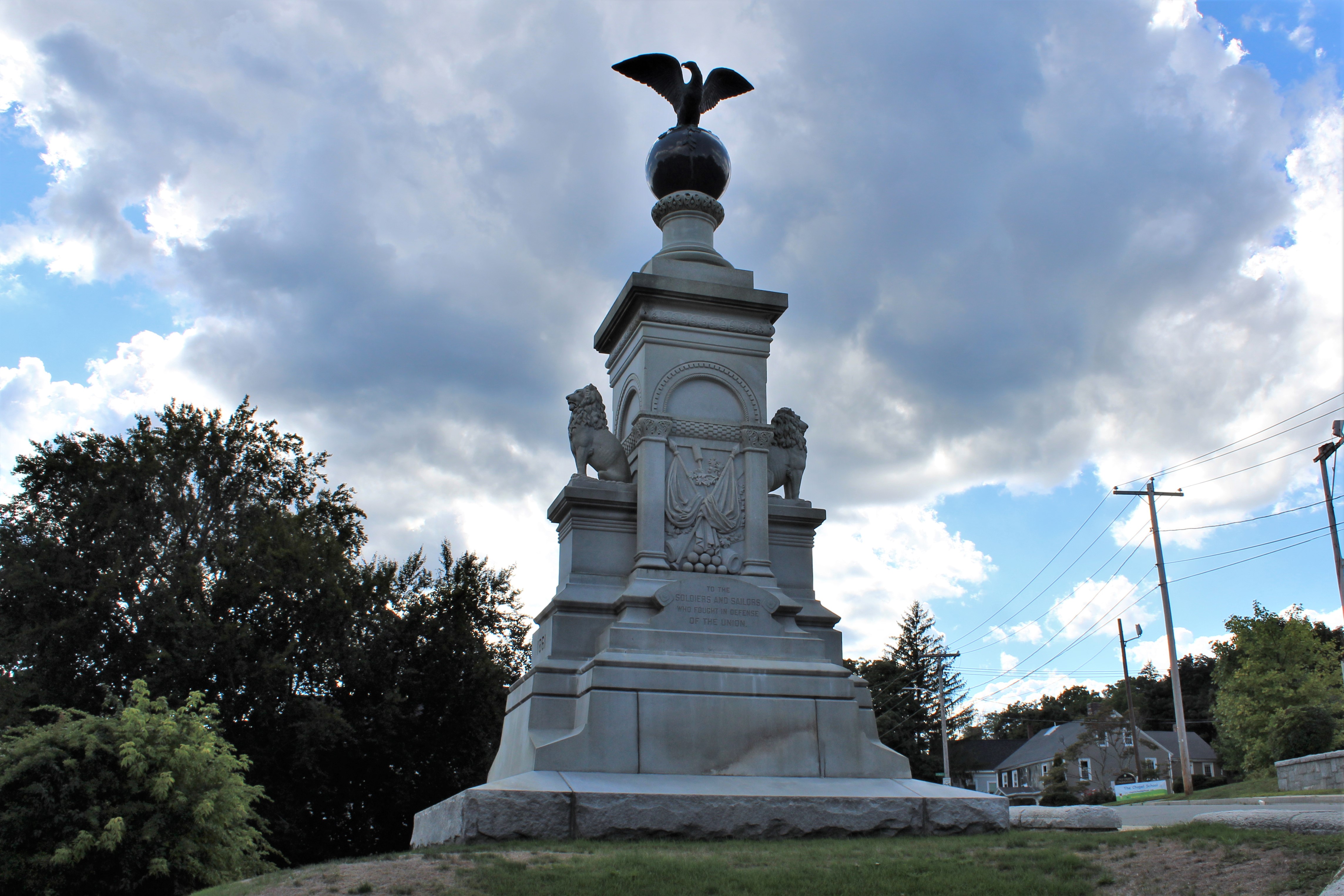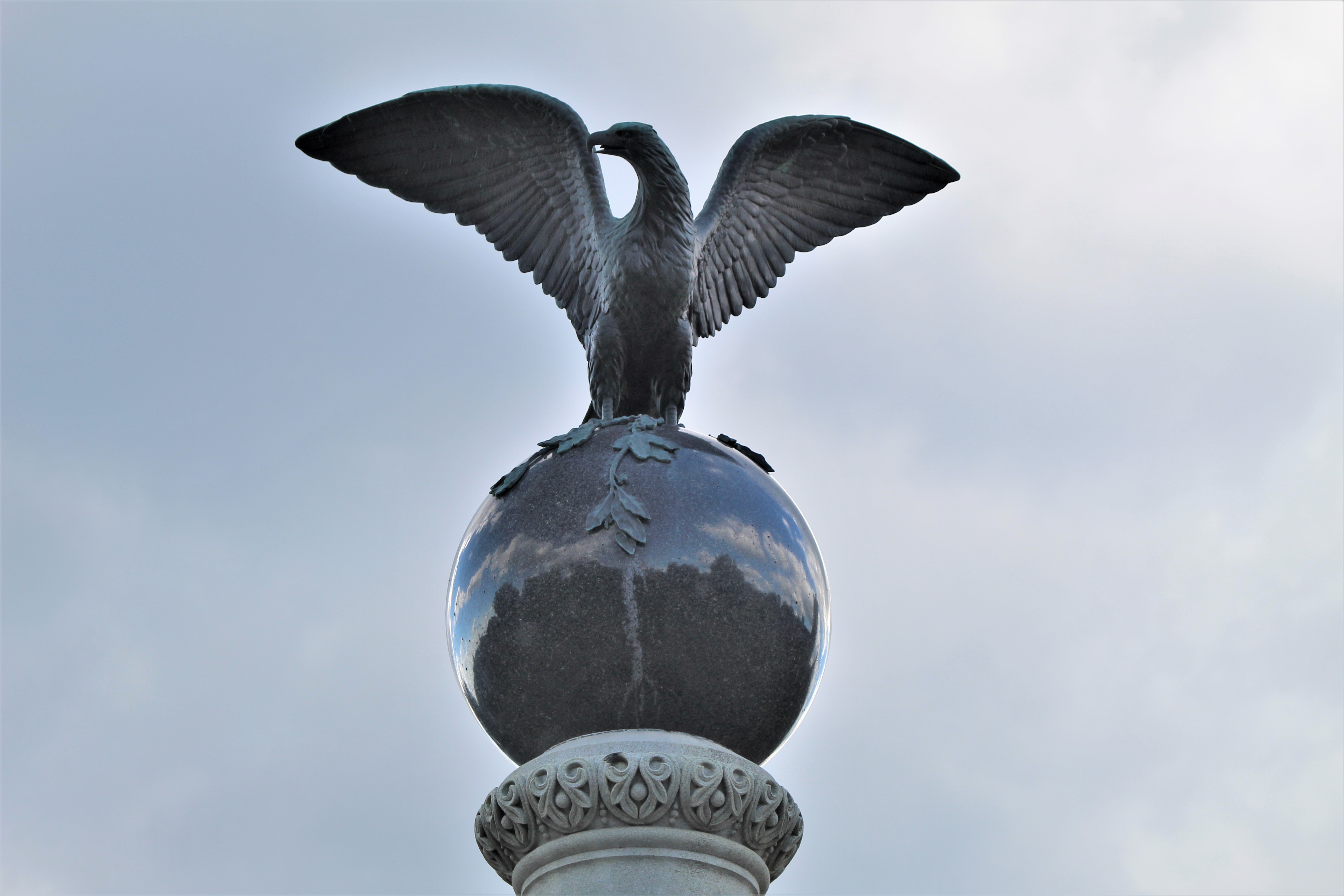

Location: Junction of Pleasant and Charles Streets, Methuen
Coordinates: 42°43’44.4″N 71°11’06.9″W
Date dedicated: July 24, 1888
Architect/contractor/sculptor: Thomas Ball, designer; Hallowell Granite Works, contractor
Charles H. Tenney of Methuen, a giant in hat manufacturing, proposed and paid for this monument, donating it to the Grand Army of the Republic, Col. William B. Greene Post 100. The GAR later gifted it to the Town of Methuen. The monument was designed by sculptor Thomas Ball, best known for his equestrian statue of George Washington in Boston’s Public Garden. The two lions are distinctive and unusual for a Civil War monument. In fact, its overall form is quite original. The dedication address was given by George B. Loring of Salem, a U.S. Representative, former Surgeon of the 7th Massachusetts Infantry, and a popular speaker booked for many monument dedications.
The contract was awarded to the Hallowell Granite Works of Hallowell, Maine–one of the largest granite companies in the country. Massachusetts municipalities typically looked to closer outfits in Quincy for their granite work. However, the founder of Hallowell Granite was a Methuen native (Joseph R. Bodwell) and so the contract went to him.
Sources: Daily Illinois State Journal, September 8, 1888, 7; Boston Journal, July 20, 1888, 4; Worcester Daily Spy, July 25, 1888, 3.
Click images to enlarge:

Walnut Grove Cemetery Monument
Location: 19 Grove Street, Methuen
Coordinates: 42°43’21.8″N 71°11’22.5″W
Date dedicated: Unknown
Architect/contractor/sculptor: Unknown
Number of names: 19 buried in the soldiers’ plot
Information is scarce regarding this memorial marking the GAR plot in Walnut Grove Cemetery. It bears the names of 19 soldiers buried there (many more Methuen veterans are buried in private plots elsewhere in the cemetery). The ranking soldier memorialized on this monument is First Sergeant Frank Sanborn, a 26 year-old hatter who enlisted as one of the “Minutemen of ’61” with the 6th Massachusetts Militia. After his first term of service was completed, he reenlisted with the 26th Massachusetts Infantry but was discharged due to illness in 1862. He then reenlisted again with the 59th Massachusetts Infantry and was killed during the Siege of Petersburg on June 29, 1864.
Source: Massachusetts Soldiers, Sailors and Marines of the Civil War








Charles Tenney was born in Methuen 1842. As far as I can tell he was not in the Civil War, nor at the time was he wealthy. Also the same with Edward Searles and perhaps Nevins. So why didn’t they serve?
Hi Dan. I can only partially answer that. David C. Nevins was 52 when the war started–so he was too old to serve. Searles’s bio on findagrave.com suggests that he did not serve because his widowed mother depended on him for support. This needs fact-checking but it was a common scenario and sounds plausible. I don’t know about Tenney. Your comment prompted me to go back and check my sources and I discovered an error–so I thank you for that. A newspaper article on the monument dedication which was widely reprinted across the country referred to him as “Capt. Charles H. Tenney.” I originally repeated the title, assuming he served. In fact, the title was either some sort of honorific or just an error (likely the latter). I’ve corrected it in this post. Best, -Patrick.
Hello Patrick.
I’m from Methuen and a history buff. Since writing the post I learned Charles H Tenney received a deferment to the 1863 draft because he had no upper teeth. Never heard of such a thing at age 21. Perhaps a tall tale. At the time he and his brothers had an interest in shoe and hat manufacturing in Methuen. Their mills must have been busy Suppling the war effort. So he and his brothers had money to opt out of serving.
Regarding David Nevins Sr. Yes, he was to old to serve and was very wealthy, owning a cotton mill and a Far East important company. David Sr had 2 sons, David Jr and Henry. Both were in there early 20’s in 1863. Due to their wealth, I doubt either served. The pictures I see of Henry in a military outfit with sword long after the war is pure hippocrocy.
Edward Searles had an older brother that served and saw action, rose in rank and lived thru it. Edward was 22 in 1863 and was teaching piano in A Maine prep school. I suppose he had the $300 to opt out of serving .
Best Regards